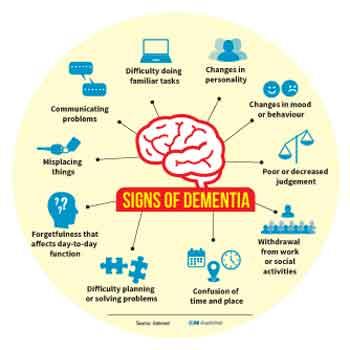09 Apr 2024 - {{hitsCtrl.values.hits}}
 Dementia is not a specific disease, but is rather a general term for the impaired ability to remember, think and make decisions that interfere with daily activities. Alzheimer’s disease is the most common type of dementia. It is a progressive disease beginning with mild memory loss and possibly leading to loss of the ability to carry on a conversation and respond to the environment. The Director at the Center for Brain and Neurocare, Maryland, USA, Dr. Ruwani Gunawardene had a lecture on Alzheimer’s Dementia (AD) at the Sri Lanka Medical Association, Colombo 07. Amyloid PET (Positron emission tomography) and Tau Pet scans are available worldwide to diagnose their patients. “Probably within the next 20 years, patients will be identified when in their early stage with Alzheimer’s dementia with first-degree relative patients as well. Alzheimer’s dementia is raising its potential, and it can be seen in young patients as well,” said Dr. Gunawardena.
Dementia is not a specific disease, but is rather a general term for the impaired ability to remember, think and make decisions that interfere with daily activities. Alzheimer’s disease is the most common type of dementia. It is a progressive disease beginning with mild memory loss and possibly leading to loss of the ability to carry on a conversation and respond to the environment. The Director at the Center for Brain and Neurocare, Maryland, USA, Dr. Ruwani Gunawardene had a lecture on Alzheimer’s Dementia (AD) at the Sri Lanka Medical Association, Colombo 07. Amyloid PET (Positron emission tomography) and Tau Pet scans are available worldwide to diagnose their patients. “Probably within the next 20 years, patients will be identified when in their early stage with Alzheimer’s dementia with first-degree relative patients as well. Alzheimer’s dementia is raising its potential, and it can be seen in young patients as well,” said Dr. Gunawardena.
 She explained how Lecanemab and Donanemab-two medications-are used to treat AD; both approved by the FDA (Food and Drug Association). Moreover, she said that 1795 patients with early AD were enrolled in the Lacanemab phase 3 Clarity AD trial. They were all positive with an Amyloid PET scan. They are fully functional, but have mild memory malfunctions due to the early stage of the disease. Further, 10mg of Lecanemab was given every two weeks for 18 months. According to her as a result of the test there was a 27% reduction of Amyloid. This medicine is very expensive.
She explained how Lecanemab and Donanemab-two medications-are used to treat AD; both approved by the FDA (Food and Drug Association). Moreover, she said that 1795 patients with early AD were enrolled in the Lacanemab phase 3 Clarity AD trial. They were all positive with an Amyloid PET scan. They are fully functional, but have mild memory malfunctions due to the early stage of the disease. Further, 10mg of Lecanemab was given every two weeks for 18 months. According to her as a result of the test there was a 27% reduction of Amyloid. This medicine is very expensive.
She exclaimed that Donanemab would be available for medication from July onwards. The trial enrolls patients with a little bit of advance in the disease. “700mg for the first 3 doses, and 1400mg thereafter, every 4 weeks for up to 72 weeks. As a side-effect, 24% of patients had ARIA-E (Amyloid Related Imaging Abnormalities edema) in the brain in the Donanemab group. It is more strongly associated with symptoms. Symptoms include headache, confusion, dizziness, visual disturbance, nausea and fatigue. The patient will have to face an MIR (Magnetic Resonance Imaging) scan to scan side by side. 31% had ARIA-H (Amyloid Related Imaging Abnormalities hemorrhages) Two deaths happened due to ARIA,” voiced Dr. Gunawardena. “Atypical AD syndromes are typically seen in patients with young-onset dementia, mostly before age 6,” said Dr. Gunawardene. She described the unusual behaviour patterns such as the patients finding it hard to find the word for the description—word finding difficulties, visual loss and getting confused with directions are some of them. “Most of the AD patients are diabetic as well,” said Dr. Gunawardene.
She mentioned a few ways to understand and prevent AD. Awareness of symptoms and risk factors is crucial for early detection and intervention. Addressing hearing loss through appropriate treatment and management helps reduce the risk of cognitive decline. She stated that smoking has been identified as a risk factor for AD. Depression can contribute to  cognitive decline and will increase the risk of developing AD. Diabetes has been linked to an increased risk of AD and other types of dementia. She added that if a person is leading a sedentary lifestyle, it will increase the risk of cognitive decline and AD. “Moreover, Regular physical activity is important for maintaining brain health. Lack of social engagement and isolation have been associated with a higher risk of cognitive decline and AD. Exposure to air pollution, particularly fine particulate matter, has been linked to an increased risk of AD” said Dr. Gunawardena.
cognitive decline and will increase the risk of developing AD. Diabetes has been linked to an increased risk of AD and other types of dementia. She added that if a person is leading a sedentary lifestyle, it will increase the risk of cognitive decline and AD. “Moreover, Regular physical activity is important for maintaining brain health. Lack of social engagement and isolation have been associated with a higher risk of cognitive decline and AD. Exposure to air pollution, particularly fine particulate matter, has been linked to an increased risk of AD” said Dr. Gunawardena.
She provided solutions to control AD; such as regular physical exercises. Avoiding red meat and saturated fat will be beneficial for brain health. A diet without red meat will help reduce AD.
29 Dec 2024 21 minute ago
29 Dec 2024 3 hours ago
29 Dec 2024 3 hours ago
29 Dec 2024 5 hours ago
29 Dec 2024 6 hours ago